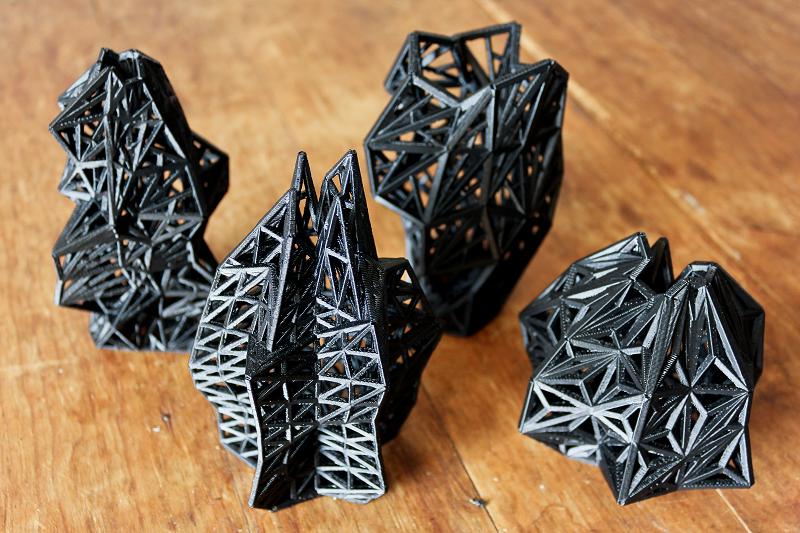With each click, the eyes are changed randomly. If the mouse is pressed, the facial expression changes, the arms move up and down, and the character switches between wearing different hats. When the pink button, blue button, or yellow sun button are clicked, either blushing circles, tear tracks, or yellow polka dots will appear.
sketch
var faceWidth = 120;
var eyeLength = 20;
var x = 200;
var y = 250;
var eyeThickness = 5; var randomEars = 1; var randomSun = 10;
function setup() {
createCanvas(640, 480);
}
function draw()
{
background (51, 0, 102);
if (mouseIsPressed & mouseX > .7 * width && mouseX < .9 * width
&& mouseY > .1*height && mouseY < .3*height)
{
fill (255, 255, 0)
strokeWeight(0);
ellipse (randomSun, randomSun*10, faceWidth/2, faceWidth/2);
ellipse (x + randomSun*4, randomSun*2, faceWidth/4, faceWidth/4);
ellipse (randomSun*20, randomSun*6, faceWidth/5, faceWidth/5);
ellipse (randomSun*7, y + randomSun*4, faceWidth/3, faceWidth/3);
ellipse (randomSun*12, y +randomSun*6, faceWidth/4, faceWidth/4);
ellipse (x + randomSun*3, randomSun*2.7, faceWidth/6, faceWidth/6);
ellipse (randomSun*2.2, y +randomSun*5.7, faceWidth/7, faceWidth/7);
ellipse (randomSun*6, y +randomSun*10, faceWidth/2, faceWidth/2);
ellipse (randomSun*12, y +randomSun*12, faceWidth/3, faceWidth/3);
ellipse (randomSun*20, y - randomSun*8, faceWidth/4, faceWidth/4);
ellipse (randomSun*32, y +randomSun*11, faceWidth/4, faceWidth/4);
ellipse (randomSun*28, y -randomSun*6, faceWidth/3, faceWidth/3);
ellipse (randomSun*38, y +randomSun*5, faceWidth/2, faceWidth/2);
ellipse (randomSun*35, y -randomSun*3, faceWidth/4, faceWidth/4);
}
strokeWeight (0);
fill (255, 0, 127);
rect (15, 15, 70, 40);
fill (0, 0, 255);
beginShape();
curveVertex(50, 100);
curveVertex(50, 100);
curveVertex(25, 150);
curveVertex(50, 175);
curveVertex(75, 150);
curveVertex(50, 100);
curveVertex(75, 150);
curveVertex(50, 100);
endShape();
fill (255, 255, 0);
ellipse (.8*width, .2*height, width/5, width/5);
strokeWeight(8);
stroke(255, 255, 0);
line ( .8*width, .2*height, .8*width + width/6, .2*height);
line ( .8*width, .2*height, .8*width, .2*height + width/6);
line ( .8*width, .2*height, .8*width, .2*height - width/6);
line ( .8*width, .2*height, .8*width - width/6, .2*height);
line ( .8*width, .2*height, .8*width + width/8, .2*height - width/8);
line ( .8*width, .2*height, .8*width - width/8, .2*height - width/8);
line ( .8*width, .2*height, .8*width + width/8, .2*height + width/8);
line ( .8*width, .2*height, .8*width - width/8, .2*height + width/8);
fill (255);
strokeWeight (0);
ellipse (x, y, faceWidth, faceWidth);
strokeWeight (eyeThickness); stroke(0);
line (x - faceWidth/5, y - faceWidth/5,
x - faceWidth/5, y - faceWidth/4 + eyeLength); line (x + faceWidth/5, y - faceWidth/5,
x + faceWidth/5, y - faceWidth/4 + eyeLength);
strokeWeight(5);
stroke(255);
fill (255);
line (x - faceWidth/5, y + faceWidth/2, x - faceWidth/3, y + faceWidth);
line (x + faceWidth/5, y + faceWidth/2, x + faceWidth/3, y + faceWidth);
line (x - faceWidth/3, y + faceWidth, x + faceWidth/3, y + faceWidth); line (x - faceWidth/5, y + faceWidth, x - faceWidth/5, y + 1.3*faceWidth);
line (x + faceWidth/5, y + faceWidth, x + faceWidth/5, y + 1.3*faceWidth); line (x - faceWidth/5, y + 1.3*faceWidth, x - faceWidth/3, y + 1.3*faceWidth);
line (x + faceWidth/5, y + 1.3*faceWidth, x + faceWidth/3, y + 1.3*faceWidth);
if (mouseIsPressed)
{
line (x - faceWidth/4, y + .6*faceWidth, x - faceWidth/2, y + faceWidth);
line (x + faceWidth/4, y + .6*faceWidth, x + faceWidth/2, y + faceWidth);
stroke(0);
ellipse (x, y + faceWidth/7, faceWidth/4, faceWidth/4);
} else
{
line (x - faceWidth/4, y + .6*faceWidth, x - faceWidth, y - faceWidth/4);
line (x + faceWidth/4, y + .6*faceWidth, x + faceWidth, y - faceWidth/4);
stroke (0);
line (x + faceWidth/5, y + faceWidth/7, x - faceWidth/5, y + faceWidth/7);
}
if (mouseIsPressed & mouseX > 15 && mouseX < 85 && mouseY > 15 && mouseY < 55)
{
strokeWeight (0);
fill (255, 0, 127);
ellipse (x + faceWidth/3, y + faceWidth/10, faceWidth/6, faceWidth/6);
ellipse (x - faceWidth/3, y + faceWidth/10, faceWidth/6, faceWidth/6);
}
if (mouseIsPressed & mouseX > 25 && mouseX < 75 && mouseY > 100 && mouseY < 175)
{
stroke (0, 0, 255);
strokeWeight(8);
line (x - faceWidth/5, 1.02*y, x - faceWidth/5, y + faceWidth/2);
line (x + faceWidth/5, 1.02*y, x + faceWidth/5, y + faceWidth/2);
strokeWeight (0);
}
if (randomEars <= 1) {
fill (0);
ellipse (x - faceWidth/2, y - faceWidth/2, faceWidth/2, faceWidth/2);
ellipse (x + faceWidth/2, y - faceWidth/2, faceWidth/2, faceWidth/2);
fill (255);
ellipse (x - faceWidth/2, y - faceWidth/2, faceWidth/4, faceWidth/4);
ellipse (x + faceWidth/2, y - faceWidth/2, faceWidth/4, faceWidth/4);
}
else if (randomEars <= 2) {
strokeWeight (0);
fill (255, 0, 0);
rect (x - faceWidth/2, y - .6*faceWidth, faceWidth, faceWidth/4);
rect (x - faceWidth/4, y - faceWidth, faceWidth/2, faceWidth/2);
fill (0);
rect (x - faceWidth/5, y - .58*faceWidth, faceWidth/2.5, faceWidth/5.5);
fill (255);
rect (x - faceWidth/9.5, y - .55*faceWidth, faceWidth/5, faceWidth/8);
}
else if (randomEars <= 3) {
strokeWeight(0);
fill (255, 0, 127);
triangle (x, y - 1.2*faceWidth, x - faceWidth/2.5, y - faceWidth/3, x + faceWidth/2.5, y - faceWidth/3);
fill (255);
ellipse (x, y - 1.2*faceWidth, faceWidth/4, faceWidth/4);
}
}
function mousePressed ()
{
eyeLength = random (8, 25);
eyeThickness = random (5, 12);
randomEars = random (0, 3);
randomSun = random (5, width/10);
}
![[OLD SEMESTER] 15-104 • Introduction to Computing for Creative Practice](../../../../wp-content/uploads/2023/09/stop-banner.png)

